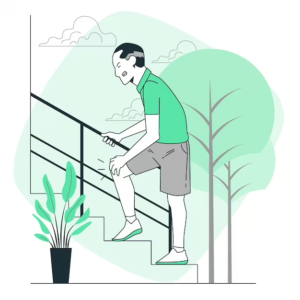Moving Backward Walking isn’t always a terrible thing. In fact, you’ll be pleased to learn that it has its own set of advantages.
Walking has always been a simple activity that everyone can do at any time and in any place. However, it is time to re-invent the wheel a little. Today, we’d like you to shift into reverse and walk backward.
You may think we’ve gone insane for benefits of walking backwards, but we’re completely in charge. In fact, science agrees with us!
According to a study published in the International Journal of Sports Medicine, backward walking and running is an excellent aerobic exercise with significant improvements in both overall weight loss and body composition.
You’ve probably heard that Backward Walking 10 to 30 minutes every day has numerous health benefits and can help you live a better life. This simple weight-bearing activity may help you minimise your risk of cardiovascular disease, maintain your weight, and possibly improve your mental health.
However, if you want to kick this simple exercise up a notch and change up your routine, simply shift into reverse and walk backward. here’s your answer.
Here are the five advantages of reverse walking that make it an excellent cardio workout:
1) Enhances coordination
Backward Walking, according to the world-renowned sportswear manufacturer Adidas, enhances coordination.

Of course, you’re travelling against your regular motion, which means you’ll need stronger body synchronisation. Your mind should also be able to better lead you. As a result, it also aids in increasing your concentration.
2) Build leg strength.

Because we normally walk forward, specific muscles on the backside of our legs do not get involved. As a result, when you reverse walk, those muscles contract and strengthen your legs.
3) Lessens the strain on your knees

According to a study published in the journal BMC Musculoskeletal Disorders, people with knee pain or who have been injured can utilise backward walking for rehabilitation because the stress on your knee is minimal.
4) Has a healing effect

Surprisingly, it is correct! Backward walking improves balance and releases happy chemicals that keep your senses quiet, according to a study published in the Journal of Physical Therapy Science.
5) Avoid back pain
Did you know that a lack of hamstring flexibility can lead to lower back pain? A research published in the Journal of Chiropractic Medicine backs it up as well! To prevent it, we recommend reverse walking for at least 15 minutes per day.

And, as previously said, weight loss is unavoidable with reverse walking.
Let’s get started on the difficult terrain.
6) Walk backwards to improve your coordination.
One of the most significant advantages of Backward Walking is that it enhances your stability and balance. In one study, 33 people were assessed to see how forward and backward walking affected their balance and gait skills. Walking backward had a good influence on both, as well as enhanced walking speed.

As we all know, forward walking is incredibly natural, and we may do it without even thinking about it. Walking backward, on the other hand, poses a fresh issue because you can’t see where you’re going. Due to the lack of visual aid, you must rely more on your spatial and body awareness. As a result, just doing so can enhance coordination and balance.
7) Lose Weight Through Retro Walking
If frequent walking helps you manage your weight, you’ll be relieved to discover that walking backwards can benefit you even more. Walking backwards has the added benefit of increasing your calorie burn.

Retro walking, among other exercises, was ranked and quantified in the Compendium of Physical Activity in 2011. Walking backwards at 3.5 miles per hour results in a whopping 6.0 metabolic equivalents (METs)! Regular walking only counts for 4.3 METs. It’s critical to remember that the higher your METs, the higher your calorie expenditure. As a result, simply going backwards will result in a 40% increase in calories burned every minute of walking.
Considerations for Reverse Walking Safety
Now that we’ve covered seven advantages of walking backwards, it’s time to change gears. Before beginning any new fitness programme, it is critical to explore how to do so safely. As a result, here are some pointers for properly incorporating this into your regimen.
If you’re going for a walk outside, find some walking companions so you don’t have to go it alone. You can walk backwards while they go forward, keeping an eye out for oncoming people and vehicles, cracked pavements and other hazards. Plus, it’ll be more enjoyable!
Before you begin stepping indoors, make sure the environment is clear of impediments. Remove any carpets, pets, furniture, toys, and other items that could get in the way of your walk.
It may be best to begin by walking backwards on a treadmill to get adjusted to the motion. Treadmills have handrails that you can grab. Begin slowly, perhaps at 1 mile per hour, then gradually increase your speed as you become more comfortable. Add an incline to your activity to receive the hill effect.
Please keep the following in mind before engaging in reverse walking:
- If you’re on a treadmill, go at a slower pace to avoid slipping.
- If you are doing it indoors, please make sure there are no rugs or furniture in the way.
- Wear adequate shoes to protect your ankles, and if you’re doing it outside, keep an eye out for people, animals, and potholes to keep yourself safe.
- You can also combine forward and backward walking for better results.
- You are now ready to depart, people. Simply put on your boots and get ready to rumble!
FAQs About Backward Walking
What Are the Advantages of Backward Walking?
Walking backwards has various health benefits, according to the research. Among these advantages are:
- Increased bodily awareness
- Better sleep
- A more powerful heart
- Increased mental clarity
- Muscle strengthening in less-used leg muscles
- Less lower back pain
- Boosted energy levels
- Less stress on the knees
- Improved mood
- Increased metabolism
How far back should I walk?
The frequency with which you walk backward is determined by your geographical location and level of comfort. It is okay to incorporate 10 to 20 minutes of exercise a few days per week. Simply doing so will strengthen your underutilised muscles and flex your hamstrings.
Is Walking Backward Beneficial to Your Knees?
Walking backwards is supposed to be quite beneficial to your knees. Backward running, in fact, was found to minimise anterior knee discomfort in a research published in the Journal of Biomechanics. As a result, one could readily conclude that walking backwards would be good as well.
Patellofemoral soreness, for example, is a very common ailment, and patellofemoral joint compression forces caused by forward walking can aggravate symptoms. Walking backwards had lower joint compression forces than Backward Walking ahead. As a result, it would be advantageous to implement, particularly if you’ve hurt your knee



















